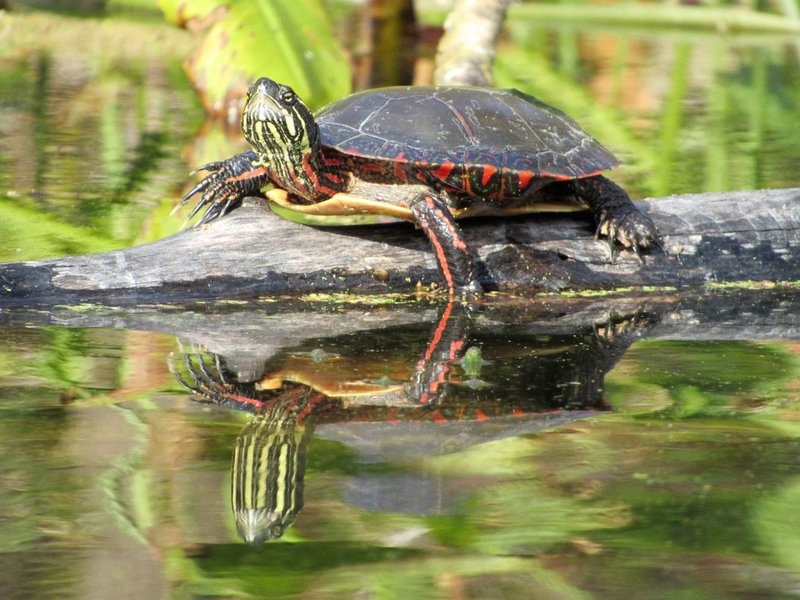
Painted turtles belong to the family Emydidae, and they’re known for their vibrant shells—often featuring striking patterns of red and yellow. They’re quite friendly and adaptable, which is why their range is impressively wide. Just like how some people feel at home at the beach while others prefer a cozy cabin in the woods, painted turtles have their particular tastes in habitats. Let’s take a closer look at the places where these charming reptiles thrive.
North American Habitats
The painted turtle is perhaps most famous in North America, specifically across the United States and Canada. They can be found from the Atlantic to the Pacific, making them one of the most widespread turtle species in the region.
You might see these turtles relaxing in various settings. They love wetlands, which offer plenty of calm water and basking spots. 🐢 Here are some popular habitats:
- Ponds
- Lakes
- Streams
- Marshes
In places like the Great Lakes region, painted turtles can be seen basking on logs or rocks during sunny days. They tend to prefer shallow waters where they can easily find food like aquatic plants, insects, and even small fish. Here’s the thing: their adaptability plays a significant role in their survival. They can live in both pristine natural environments and more developed areas where human activity is present.
Geographical Distribution
Beyond North America, painted turtles have made their mark in various parts of the world, although their primary population remains in the U.S. and Canada. In fact, there are several subspecies of painted turtles, each with its unique geographic range.
1. Eastern Painted Turtle (Chrysemys picta picta): Found in the northeastern U.S. and parts of Canada.
2. Western Painted Turtle (Chrysemys picta bellii): This one is common in the western U.S., including regions like Montana and California.
3. Southern Painted Turtle (Chrysemys picta dorsalis): Predominantly found in the southern states, from Texas to Florida.
4. Midland Painted Turtle (Chrysemys picta marginata): These turtles can be spotted in the central U.S., often in more secluded habitats.
You might be wondering why they’ve adapted so well to different environments. The answer lies in their versatility. Painted turtles can thrive in a range of temperatures and water quality, making them more versatile than some other turtle species.
Behavior and Habitat Preferences
So, what makes painted turtles tick when it comes to choosing their homes? It all boils down to a few key factors.
– Temperature: Painted turtles are ectothermic, meaning they rely on external heat sources to regulate their body temperature. They prefer warm waters, especially during the breeding season when they become more active.
– Basking Areas: These turtles need spots to sunbathe. Rocks, logs, and even floating vegetation provide excellent platforms for them to soak up some sun. This is essential for their health, as basking helps them regulate their temperature and absorb UV rays.
– Food Sources: As mentioned earlier, they enjoy a varied diet. Finding a habitat where they can easily hunt for food is crucial. So, areas rich in vegetation are ideal.
In essence, painted turtles are like little goldilocks in the wild—they seek habitats that are “just right” for their needs. It’s pretty fascinating to see how their behavior and habitat preferences shape where they live.
Conservation Status
Even though painted turtles are common, they aren’t without their challenges. Habitat destruction, pollution, and climate change have begun to threaten their populations in some regions. Urban expansion can lead to the loss of wetlands and other crucial habitats.
Efforts are ongoing to protect these turtles. Many organizations work to preserve their habitats and educate the public about their importance. It’s essential to consider our actions—like securing plastic waste and respecting natural habitats—because protecting these species often starts with us.
Painted Turtles Around the World
While painted turtles are primarily found in North America, they have also been introduced to other areas. For instance, they can sometimes be found in parts of Europe and Asia, mainly due to pet releases. Unfortunately, this can disrupt local ecosystems and outcompete native species.
In countries where they’ve been introduced, they can thrive, but their presence isn’t always welcome. People need to be cautious about releasing any pet turtles into the wild. It’s like adding a new player to a game when they don’t know the rules—they can cause chaos!
Painted turtles are more than just a pretty face. They serve vital roles in their ecosystems, and their adaptability allows them to thrive in various habitats. From the serene ponds of North America to the occasional ponds of Europe, these turtles have made their mark around the globe.
Next time you’re near a body of water, take a moment to look for these little sunbathers. Their presence is a reminder of the beauty and diversity of wildlife around us. Understanding where they live helps us appreciate them even more, along with our role in protecting their homes. Let’s ensure that painted turtles continue to bask in the sun for generations to come!

